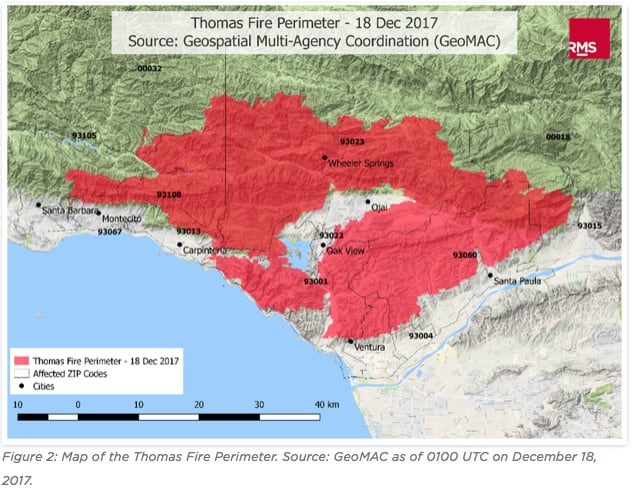
A project to build a solar+storage community microgrid within the Montecito, CA, fire district is being developed as a national model for other communities across the country, according to the Clean Coalition and the World Business Academy. The two organizations are boot-strapping the project and have raised some funding for the estimated 1 megawatt microgrid, within the unincorporated community of about 10,000 in Santa Barbara County.
The Montecito Community Microgrid Initiative is one response to the devastating Thomas Fire in December 2017, and the mud slides that followed in January 2018. Two persons were killed and 300,000 acres were burned in the fire, then 15-foot mud rivers killed 23 and damaged 400 homes.
The devastated areas lie within the Goleta Load Pocket, a region that spans 70 miles of coastline, encompassing the cities of Goleta, Santa Barbara (including Montecito), and Carpinteria, according to the initiative. The region is a highly transmission-vulnerable, served by a single transmission line.
Last week, the Montecito Fire Protection District Board of Directors unanimously approved moving forward on an MOU to proceed with Community Microgrid efforts for its headquarters and fire stations, according to the initiative. Next week, the initiative officials will meet with the local water utility to advance the idea of a microgrid for its service area. The sanitation utility is also a target for a microgrid.
The Clean Coalition and the World Business Academy work will involve staging the Montecito project, which includes aligning stakeholders, performing engineering and economic analyses, and identifying investors to leverage the tax credits that are available to the parties that will own the Community Microgrid assets. The energy from the microgrid generation sites will be delivered to end users through power purchase agreements (PPAs).
The Fire Department microgrid is the first of several conceptually planned for Montecito. The Montecito Community Microgrid Initiative aims to build multiple community microgrids in the area, ensuring the continuous operation of critical and priority facilities in the event of future disasters, the initiative says. The project also will provide ongoing energy resilience to the broader Santa Barbara region that is served from Southern California Edison’s Goleta Substation.
“The Fire Department is all too familiar with the dangers posed by extreme weather events like the Thomas Fire and the subsequent debris flow. This modern energy system will enable us to better serve the Montecito community, as well as provide much-needed redundancy to our essential service,” “said Montecito Fire Chief Chip Hickman, in a statement.
Following the Fire Department microgrid, plans are to extend other microgrids to cover a gas station, banks, the post office, the Montecito Association headquarters, supermarkets, pharmacies, restaurants, and a hotel casino.
The Montecito project is one of eight different configurations across the country that the Clean Coalition hopes to develop as demonstration community microgrids, according to Craig Lewis, the founder of the Menlo Park, CA-based group.
The eight configurations include:
- Direct current (DC) and alternating current (AC) solar+storage couplings
- Behind-the-meter (BTM) and wholesale distributed generation (WDG) proximities to the customer meter
- Net energy metering (NEM) and Feed-In Tariff (FIT) rate tariffs
- Rule 21 and wholesale distribution tariff (WDT) interconnection tariffs
Among other demonstration microgrids in California are the North Bay Community Resilience Initiative in Sonoma and Napa Counties, and the Valencia Gardens Energy Storage Project. In New York, projects include the Hunters Point Community Microgrid Project, and the Long Island Community Microgrid Project.
The Clean Coalition states, “The Community Microgrid Initiative is designed to achieve Community Microgrid demonstration projects that prove that local renewables connected to the distribution grid can provide at least 25% of the total electric energy consumed while maintaining grid reliability and power quality.”
Among configurations for microgrid demonstration projects is a lower-cost capacity design. The amount and location of local renewables would be brought online, using existing voltage regulation and advanced inverters, with minimal investment in the distribution grid. A medium-cost capacity involves local renewables that can be brought online with cost-effective storage and some investment in the distribution grid. And a higher-cost capacity design involves local renewables that can island essential services with additional storage, local reserves, and more substantial investment in the distribution grid, Clean Coalition explains.
“Serving as models for modernizing America’s electrical system in the most intelligent manner possible, these Community Microgrid demonstration projects will help realize the Clean Coalition’s vision: From 2025 onward, at least 25% of all electricity generated from newly added generation capacity in the United States will be from local renewable energy sources,” the group states.
